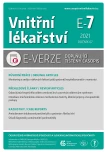-
Medical journals
- Career
Amanita phalloides intoxication: mechanism of toxicity, clinical manifestations and therapeutic approaches
Authors: Eva Kieslichová
Authors‘ workplace: 1. lékařská fakulta Univerzity Karlovy, Praha ; Klinika anesteziologie, resuscitace a intenzivní péče, Institut klinické a experimentální medicíny, Praha
Published in: Vnitř Lék 2021; 67(E-7): 13-17
Category: Review Articles
Overview
Ingestion of Amanita phalloides is the most common cause of fatal mushroom poisoning. The clinical picture of intoxication varies from mild subclinical manifestation to lethal fulminant course with the development of acute liver failure. Early diagnosis of Amanita phalloides poisoning is crucial for the outcome but i tis difficult because it is often mistaken as gastroenteritis or due to other mushroom poisoning. The diagnosis is based on the history of recent mushroom ingestion followed by gastrointestinal symptoms, typical time course and laboratory markers and is proven with mycological examination or toxicological examination. Specific treatment consists of detoxification procedures, supportive measures, administration of drugs and therapy in the specialized intensive care unit in the case of acute liver failure. In selected patients with acute liver failure urgent liver transplantation is the only life-saving option.
Keywords:
intoxication – acute liver failure – Amanita phalloides – urgent liver transplantation
Sources
1. Karlson‑Stiber C, Persson H. Cytotoxic fungi‑an overview. Toxicon, 2003; 42(4): 339–349.
2. Diaz JH. Amatoxin‑Containing Mushroom Poisonings: Species, Toxidromes, Treatments, and Outcomes. Wilderness Environ Med 2018; 29(1): 111–118.
3. Broussard CN, Aggarwal A, Lacey SR et al. Mushroom poisoning–from diarrhea to liver transplantation. Am J Gastroenterol, 2001; 96 (11): 3195–3198.
4. Mas A. Mushrooms, amatoxins and the liver. J Hepatol, 2005; 42(2): 166–169.
5. Ganzert M, Felgenhauer N, Zilker T. Indication of liver transplantation following amatoxin intoxication. J Hepatol, 2005; 42(2): 202–209.
6. Escudie C. Francoz JP, Vine R et al. Amanita phalloides poisoning: reassessment of prognostic factors and indications for emergency liver transplantation. Journal of Hepatology, 2007; 46(3): 466–473.
7. Himmelmann A, Mang G, Schnorf‑Huber S. Lethal ingestion of stored Amanita phalloides mushrooms. Swiss Med Wkly, 2001;131(41-42): 616–617.
8. Garcia J, Costa VM, Carvalho A et al. Amanita phalloides poisoning: mechanisms of toxicity and treatment. Food Chem Toxicol, 2015; 86 : 41–55.
9. Le Darre B, Ferron PJ, Gicquel T. Toxic effects of amanitins: Repurposing toxicities toward new therapeutics. Toxins, 2021; 13(6): 417.
10. Santi, L, Maggioli C, Mastroroberto M et al. Acute Liver Failure Caused by Amanita phalloides Poisoning. Int J Hepatol, 2012; 2012 : 487–480.
11. European Association for the Study of the Liver. EASL Clinical Practical Guidelines on the management of acute (fulminant) liver failure. J Hepatol, 2017; 66(5): 1047–1081.
12. Montrief T, Koyfman A, Long B. Acute liver failure: A review for emergency physicians. Am J Emerg Med, 2019; 37(2): 329–337.
13. Enjalbert F, Rapior S, Nouguier‑Soulé J et al. Treatment of amatoxin poisoning: 20-year retrospective analysis. J Toxicol Clin Toxicol, 2002; 40(6): 715–757.
14. Ye Y, Liu Z. Management of Amanita phalloides poisoning: a literature review and update. J. Crit Care, 2018; 46 : 17–22.
15. Lacombe G. Towards evidence‑based emergency medicine: best BETs from the Manchester Royal Infirmary. BET 1: Silibinin in suspected amatoxin ‑ containing mushroom poisoning. Emerg Med J, 2016; 33(1): 76–77.
16. Ganzert M, Felgenhauer N, Schuster T et al. Amanita poisoning – comparison of silibinin with a combination of silibinin and penicillin. Dtsch Med Wochenschr, 2008; 133(4): 2261–67.
17. Liu J, Chen Y, Gao Y, et al. N‑acetylcysteine as a treatment for amatoxin poisoning: a systematic review. Clin Toxicol (Phila), 2020; 58(11): 1015–1022.
18. Mullins ME, Horowitz BZ. The futility of hemoperfusion and hemodialysis in Amanita phalloides poisoning. Vet Hum Toxicol, 2000; 42(2): 90–91.
19. Jander S, Bischoff J, Woodcock BG. Plasmapheresis in the treatment of Amanita phalloides poisoning: II. A review and recommendations. Ther Apher, 2000; 4(4): 308–312.
20. Karvellas CJ, Tillman H, Leung AA et al. United States Acute Liver Failure Study Group. Acute liver injury and acute liver failure from mushroom poisoning in North America. Liver Int, 2016; 36(7): 1043–1050.
21. Seetharam A. Intensive care management of acute liver failure: Considerations while awaiting liver transplantation. J Clin Transl Hepatol, 2019; 7(4): 384–391.
22. Kieslichová E, Fraňková S, Protuš M et al. Acute liver failure due to Amanita phalloides poisoning: therapeutic approach and outcome. Transplantation Proceedings 2018; 50(1): 192–197.
Labels
Diabetology Endocrinology Internal medicine
Article was published inInternal Medicine

2021 Issue E-7-
All articles in this issue
- Monitoring and analysis of fall risk factors in hospitalized patients
- Recommendations for safe collection of venous blood by a closed collection system
- Amanita phalloides intoxication: mechanism of toxicity, clinical manifestations and therapeutic approaches
- Amiodarone induced pulmonary toxicity
- Pitfalls of diagnosing autoimmune pancreatitis
- Internal Medicine
- Journal archive
- Current issue
- Online only
- About the journal
Most read in this issue- Amanita phalloides intoxication: mechanism of toxicity, clinical manifestations and therapeutic approaches
- Amiodarone induced pulmonary toxicity
- Recommendations for safe collection of venous blood by a closed collection system
- Pitfalls of diagnosing autoimmune pancreatitis
Login#ADS_BOTTOM_SCRIPTS#Forgotten passwordEnter the email address that you registered with. We will send you instructions on how to set a new password.
- Career

